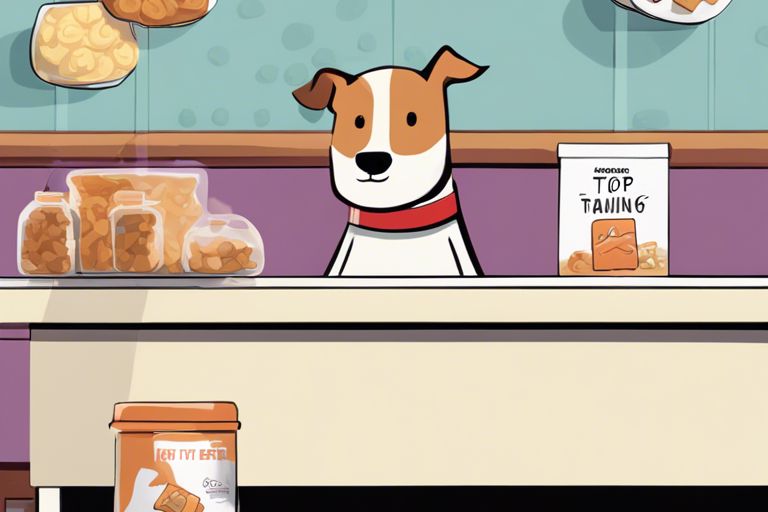Enriching the training experience for your furry friend with the right treats is crucial for success. The best treats for training your dog should be high-value rewards that your pet finds irresistible. This will keep them engaged and motivated during training sessions. Look for treats that are small and easy to consume, as well as soft and chewy to prevent interruptions in the training process. Avoid treats that are too hard, as they can be difficult for your dog to eat quickly and can cause a choking hazard. Opt for treats that are low in calories to avoid overfeeding, and ensure they are made with healthy, natural ingredients to promote overall well-being. Remember, finding the perfect treat for your dog may require some trial and error, so be patient and observant of what your pet responds to best. Happy training!
Key Takeaways:
- High Value, Smelly Treats: Use treats that your dog finds irresistible and can easily smell from a distance, such as small pieces of cooked chicken or cheese.
- Small, Quick-to-Eat Treats: Opt for small treats that your dog can quickly consume to keep the training momentum going, such as small training treats or cut-up pieces of soft dog food.
- Varied, Novel Treats: Keep your dog engaged by using a variety of treats during training sessions to maintain their interest and motivation.
Understanding Your Dog’s Preferences
One of the most important factors in using treats for training your dog is understanding their preferences. Just like humans, dogs have individual tastes and preferences when it comes to food. By understanding what your dog likes and dislikes, you can choose the most effective treats for training.
Identifying Your Dog’s Favorite Flavors
When identifying your dog’s favorite flavors, pay attention to their reactions when offered different types of treats. Notice which treats they eagerly gobble up and which ones they show less interest in. Some dogs may have a preference for meaty treats, while others might prefer something on the sweet side. By observing your dog’s reactions, you can tailor your training treats to their specific preferences, ultimately making training more effective and enjoyable for them.
Considering Dietary Restrictions and Allergies
It’s important to consider any dietary restrictions and allergies your dog may have when choosing treats for training. Some dogs may have sensitivities to certain ingredients, such as grains or certain proteins. It’s crucial to avoid treats that could potentially trigger an allergic reaction or cause digestive issues. Before introducing any new treats, consult with your veterinarian to ensure that they are safe for your dog to consume. Keeping your dog’s dietary needs in mind will help maintain their overall health and well-being while using treats for training.

Types of Training Treats
Clearly, there are several types of training treats that you can use to reward your dog during training sessions. Here is a breakdown of the most common types:
- Commercial Dog Treats: These are pre-packaged and readily available at pet stores or online, and come in a variety of flavors and textures.
- Homemade Treats: These are treats that you can make at home using dog-friendly ingredients, allowing you to control the quality and nutritional value of the treats.
- Soft Treats: These are often chewy and can be easily broken into small pieces for training purposes.
- Crunchy Bites: These are hard and crunchy treats that can provide a satisfying crunch for your dog during training.
- Interactive Treats: These are treats that are designed to be used in interactive toys or puzzles, providing mental stimulation along with a reward.
Recognizing the different types of training treats available will help you find the best option for your dog’s training needs.
Commercial Dog Treats vs. Homemade Options
When it comes to choosing training treats for your dog, you have the option of using commercial dog treats or making homemade treats. Commercial treats are convenient and come in a variety of flavors, but they may contain preservatives and additives that are not ideal for your dog’s health. On the other hand, homemade treats allow you to control the ingredients and ensure that your dog is getting a treat that is both delicious and nutritious. You can also tailor homemade treats to your dog’s specific dietary needs and taste preferences.
Soft Treats, Crunchy Bites, and Interactive Treats
When considering training treats, it’s important to think about the texture and type of treat that will best motivate your dog. Soft treats are often preferred for training as they can be easily broken into small pieces and are quickly consumed, keeping your training sessions moving smoothly. Crunchy bites can provide a satisfying crunch for your dog and may be more suitable for certain training scenarios. Interactive treats, such as those used in treat-dispensing toys, can provide both a physical and mental challenge for your dog, making them a valuable addition to your training toolkit.
Treat Size, Frequency, and Timing
Now that you’ve selected the best treats for training your dog, it’s important to consider the size, frequency, and timing of these treats to ensure effective training. Proper portioning, timing, and frequency of treats can significantly impact your dog’s learning and behavior. Let’s delve into these important factors to help you maximize the effectiveness of your training sessions.
Proper Treat Portioning for Effective Training
When it comes to using treats for training, portion control is key. Over-feeding your dog during training sessions can lead to weight gain and other health issues. It’s important to use small, bite-sized treats that your dog can consume quickly without getting full too soon. By breaking larger treats into smaller pieces, you can effectively reward your dog without overindulging them. Aim for treats that are around the size of a pea to ensure your dog stays motivated throughout the training session. Remember, the goal is to reward, not to overfeed.
Timing Treats for Optimal Engagement
Timing is crucial when it comes to using treats for training. Timing your treat rewards correctly can reinforce the desired behavior and improve your dog’s engagement. When your dog performs the desired behavior, immediately reward them with a treat to create a strong association between the behavior and the reward. Delaying the treat can lead to confusion and reduce the effectiveness of the training. Additionally, be consistent with the timing of your rewards to avoid unintentionally reinforcing unwanted behaviors. It’s important to reward your dog at the precise moment they exhibit the desired behavior to ensure optimal engagement and learning.
Health Considerations and Treat Alternatives
After considering the best treats for training your dog, it’s important to also think about the health considerations and alternative options. While treats are a valuable tool for positive reinforcement, it’s essential to ensure that you are not compromising your dog’s health in the process. Here are some important points to keep in mind.
Balancing Treats with Regular Meals
When using treats for training, it’s crucial to strike a balance and not overwhelm your dog’s regular diet. In order to maintain a healthy weight and prevent nutritional imbalances, you should carefully regulate the amount of treats your dog receives. One approach is to reduce the portion size of your dog’s regular meals to compensate for the extra calories received from treats. Alternatively, you can opt for low-calorie treats that won’t significantly impact your dog’s overall daily calorie intake. Keep in mind that small breed dogs have different nutritional needs and may require even more careful consideration when it comes to treat portions.
Non-Food Rewards for Dogs
It’s important to expand your training repertoire beyond just food treats. While food rewards are effective, it’s also beneficial to incorporate non-food rewards as well. This can include praise, attention, playtime, or toys. By introducing a variety of rewards, you can prevent your dog from becoming overly food-motivated and maintain a healthy balance. Additionally, non-food rewards can be particularly useful for dogs with specific dietary restrictions or health concerns. Remember, the most important thing is to find what motivates your individual dog and use a combination of rewards to keep training engaging and effective.
Conclusion
Taking this into account, the best treats to use for training your dog are high-value, bite-sized, and easily digestible. Look for treats made with real meat or high-quality ingredients, as these are more likely to capture your dog’s attention and motivate them to perform the desired behavior. It’s also important to be mindful of your dog’s dietary needs and any allergies they may have when selecting treats for training. Remember, the key to successful training is finding a treat that your dog truly loves and sees as a special reward for their hard work. With the right treats in hand, you’ll be on your way to a well-behaved and enthusiastic pup in no time.














